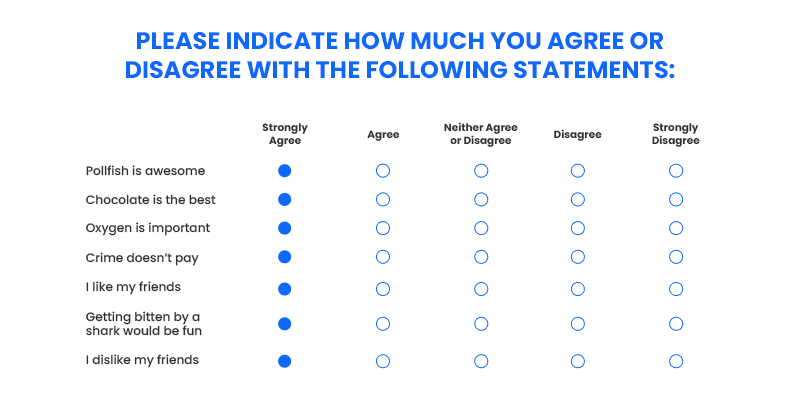5 Types of Survey Respondents to Keep an Eye On

When conducting a survey, it is essential to understand that, no matter how sophisticated the platform you use is, not all survey responders are keen on taking it the way you’d like.
That is to say that there will be some respondents who speed through a survey to be done with it as soon as they can, while others will take it more diligently.
These different kinds of survey respondents are not necessarily bound by a demographic; rather their style and behavior when taking surveys gives rise to their labels. Oftentimes, this is something that you can’t narrow down on a survey’s screener. You can, however, question responders on their survey-taking behaviors.
There are five types of survey respondents worth noting in your market research endeavors. They are personas — survey respondent personas to be exact — in their own right. Learn about the five respondent personas so that you can understand how your survey will be received.
The Survey Aficionados
To start this roster on a positive note, we begin by introducing the survey aficionado. Usually categorized as one of the good kinds of survey takers, survey aficionados make it their business to take surveys — they treat it as their job, or at least a source of supplemental income.
They manifest their devotion to survey-taking by taking them frequently and consuming them across websites and mobile apps. This is usually a positive behavior for marketers and market researchers, as aficionados provide sought-after participation.
However, survey aficionados can also hurt surveys, in that constant participation can yield biased results. This is especially true if they take part in surveys that deal with similar subjects.
How to attract and avoid this persona:
To attract survey aficionado respondents, offer an incentive in exchange for taking your survey. This is usually the draw of taking so many surveys for this persona, as there’s something in it for their gain.
To avoid survey aficionado respondents, screen them by asking if they’ve taken part in a recent survey on a related topic.
If you can’t do this in the screening stage of your survey, choose a platform that allows you to apply skip logic in your questionnaire.
This mechanism allows you to move a respondent to your question of choice based on their answer to a question. This way, you will avoid asking them certain questions or end the survey right then and there if they’re a bad fit.
The Flatliners
Also called straightliners, these responders engage in negative behavior when taking a survey. Flatliners tend to regularly respond as either extreme on a Likert scale survey (a survey that measures the magnitude of attitudes, opinions, or beliefs on a scale of answers, such as “highly likely” to “highly unlikely”).
As such, it is in their nature to habitually respond either on the positive end of the scale (with “strongly agree”) or on the negative side (with “strongly disagree”). Or they may respond with another answer type — continuously.
The motivation for behaving in such a way is often to complete a survey as soon as possible, making this persona a predominant kind of speeder.

Another underlying motivation for flatliners is an innate bias, such as acquiescence bias or dissent bias.
How to avoid flatliners:
Lay off of grid or matrix questions, as they are the most likely to knuckle under the behaviors of this persona.
Use one question per page (or find a platform that does this).
If you use a platform that applies multiple questions per page, make sure they are similar.
Implement more open-ended questions that deal with the matter. Additionally, use skip logic to lead respondents to answer why they chose a particular answer to a Likert Scale question.
The Fakers
These respondents’ behavior is self-evidently negative. This persona deals with responders who do not provide genuine answers, only fake ones, hence the name. The motivation is usually to reap the reward for taking a survey.
The Fakers operate in three ways:
They create multiple accounts on a website to repeatedly take the same survey.
They use one account to take the same survey multiple times.
The most technically savvy and malicious fakers create bots to take surveys without doing the work of a survey.
Weeding out fakers has become increasingly easier, as both survey panels and platforms rely on advanced restriction functionalities.
How to avoid the fakers:
Use a platform with built-in anti-bot technology.
Use a platform that bars responders with the same IP address from taking the same survey more than once.
Ask more open-ended questions. These will easily spot fakers, as they require longer, more thought-out answers, which are much more laborious than selecting an option.
The Rule-Breakers
Much like the cheaters, and as their name implies, rule-breakers don’t adhere to the directions of a survey. While some are just looking to cause trouble and some want to finish the survey quickly, other responders may be breaking the rules unintentionally.
This is usually the result of not fully understanding a question or completely misconstruing it. Rule-breakers are a nuisance, but like the other personas, they too can be avoided.
How to avoid the rule-breakers:
Use several screening questions to prohibit the wrong kinds of respondents.
Discard respondents who manifest their lack of attention in open-ended questions.
Use skip logic to avoid possible rule-breakers, by moving responders to relevant questions only.
The Posers

Not to be confused with the fakers, posers also provide false feedback, but not because they are bots or manage multiple accounts to take the same survey more than once.
Rather, they provide dishonest responses because of a social desirability bias, a kind of inclination to answer questions in a way they believe will be viewed more favorably. This means their feedback can over-report “good responses” while downplaying the “bad responses.”
Posers do not necessarily act as their moniker in every situation, instead, they may only behave as such when answering questions on certain topics. Due to this, posters can be hard to pinpoint, but they can still be avoided.
How to avoid the posers:
When dealing with particularly sensitive topics, assuage your respondents by telling them that they are not being judged (especially in the beginning).
Assure your responders that their answers are anonymous.
Remind your responders of the importance of the accuracy of their answers.
Handling Survey Respondent Personas
With surveys becoming ever so dominant in market research, there have been evaluations on how respondents behave during their participation. Thus, the birth of five unique survey respondent personas was born.
You may discover other names for similar behaviors when reading up about these personas. Regardless of what they are called, they each present unique challenges to your market research study.
These personas may not all relate to your pool of respondents; that is why it is important to assess your surveys and look for behavioral patterns.
This is not as tedious as it appears, as some behaviors may be more obvious than others. It’s also important to rise to the challenge of understanding your customer base. You can do so by conducting the right surveys. If you can’t spot any of these personas, it is still worth sticking to the aforementioned best practices as they can prevent the “bad” types of respondents from influencing your study.
Frequently asked questions
What is a survey?
A survey is a research method that is used to gather information from a group of people in order to gain insights about a particular topic.
What are survey respondents?
In survey research, the term “survey respondents” refers to the people who take part in a survey. They make up the sampling pool.
Why is it important to be aware of certain survey personas?
In order to gain accurate and valuable insights from a survey, a company depends upon survey respondents providing truthful, unbiased information. When a large number of poor-quality responses are received, it can affect the accuracy of survey results.
What are survey aficionados?
Also known as professional survey respondents, survey aficionados are individuals who take surveys in order to make money. They are motivated to complete surveys quickly so they can respond to a large volume of surveys.
How can a company improve the quality of survey responses?
A company can increase the likelihood of gathering genuine responses by using strong screening questions and creating a well-designed survey with a good mix of survey questions.
Pollfish Marketing Team
Ready to Try Pollfish?
Create your survey with AI, target high-quality respondents starting at $0.95 per complete, and start getting results in just minutes in real-time. From running a simple product concept survey to managing a constant stream of trackers for dozens of clients in dozens of countries, we’ve got you.
